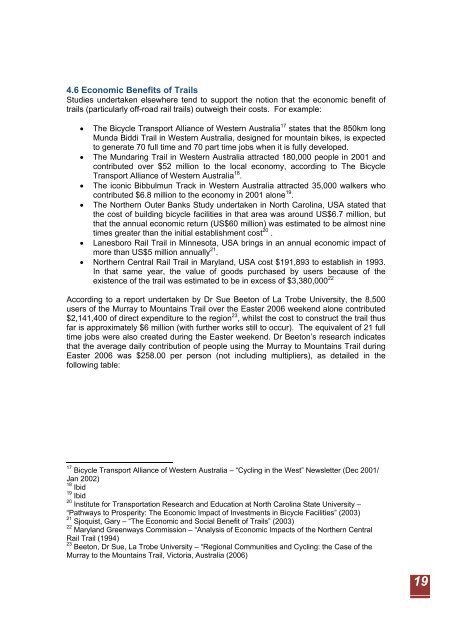Loddon Tracks and Trails Strategy - Loddon Shire Council
Loddon Tracks and Trails Strategy - Loddon Shire Council
Loddon Tracks and Trails Strategy - Loddon Shire Council
You also want an ePaper? Increase the reach of your titles
YUMPU automatically turns print PDFs into web optimized ePapers that Google loves.
4.6 Economic Benefits of <strong>Trails</strong><br />
Studies undertaken elsewhere tend to support the notion that the economic benefit of<br />
trails (particularly off-road rail trails) outweigh their costs. For example:<br />
• The Bicycle Transport Alliance of Western Australia 17 states that the 850km long<br />
Munda Biddi Trail in Western Australia, designed for mountain bikes, is expected<br />
to generate 70 full time <strong>and</strong> 70 part time jobs when it is fully developed.<br />
• The Mundaring Trail in Western Australia attracted 180,000 people in 2001 <strong>and</strong><br />
contributed over $52 million to the local economy, according to The Bicycle<br />
Transport Alliance of Western Australia 18 .<br />
• The iconic Bibbulmun Track in Western Australia attracted 35,000 walkers who<br />
contributed $6.8 million to the economy in 2001 alone 19 .<br />
• The Northern Outer Banks Study undertaken in North Carolina, USA stated that<br />
the cost of building bicycle facilities in that area was around US$6.7 million, but<br />
that the annual economic return (US$60 million) was estimated to be almost nine<br />
times greater than the initial establishment cost 20 .<br />
• Lanesboro Rail Trail in Minnesota, USA brings in an annual economic impact of<br />
more than US$5 million annually 21 .<br />
• Northern Central Rail Trail in Maryl<strong>and</strong>, USA cost $191,893 to establish in 1993.<br />
In that same year, the value of goods purchased by users because of the<br />
existence of the trail was estimated to be in excess of $3,380,000 22<br />
According to a report undertaken by Dr Sue Beeton of La Trobe University, the 8,500<br />
users of the Murray to Mountains Trail over the Easter 2006 weekend alone contributed<br />
$2,141,400 of direct expenditure to the region 23 , whilst the cost to construct the trail thus<br />
far is approximately $6 million (with further works still to occur). The equivalent of 21 full<br />
time jobs were also created during the Easter weekend. Dr Beeton’s research indicates<br />
that the average daily contribution of people using the Murray to Mountains Trail during<br />
Easter 2006 was $258.00 per person (not including multipliers), as detailed in the<br />
following table:<br />
17<br />
Bicycle Transport Alliance of Western Australia – “Cycling in the West” Newsletter (Dec 2001/<br />
Jan 2002)<br />
18<br />
Ibid<br />
19<br />
Ibid<br />
20<br />
Institute for Transportation Research <strong>and</strong> Education at North Carolina State University –<br />
“Pathways to Prosperity: The Economic Impact of Investments in Bicycle Facilities” (2003)<br />
21<br />
Sjoquist, Gary – “The Economic <strong>and</strong> Social Benefit of <strong>Trails</strong>” (2003)<br />
22<br />
Maryl<strong>and</strong> Greenways Commission – “Analysis of Economic Impacts of the Northern Central<br />
Rail Trail (1994)<br />
23<br />
Beeton, Dr Sue, La Trobe University – “Regional Communities <strong>and</strong> Cycling: the Case of the<br />
Murray to the Mountains Trail, Victoria, Australia (2006)<br />
19


